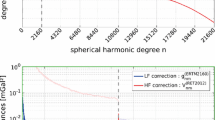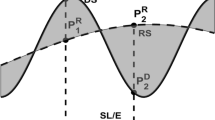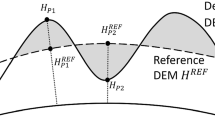Abstract
We present two novel approaches to residual terrain modelling (RTM), one of which is practical and the other rather theoretical. The first provides a solution to the harmonic correction issue and the high-frequency error of the spectral filter problem. As its key feature, cap-modified spectral gravity forward modelling is applied to deliver near-zone gravity effects induced by the reference (smooth) topography. Thanks to its spectral nature, the sought gravity can be evaluated at the problematic points inside the smooth topography by regularized downward continuation (solution for the harmonic correction problem), and, at the same time, it is band-limited in spherical harmonics (solution for the high-frequency error). A validation over two mountainous areas, Switzerland and Slovakia, reveals that this technique is at least comparable with two other common RTM variants (RMS agreement up to 0.1 mGal). Finally, we formulate the theoretical RTM concept, showing that the harmonic correction issue and the spectral filter problem are caused by filtering of the mass model in the topography domain. When properly filtering gravity effects in the gravity domain, that is, avoiding the concept of the reference topography, both problems disappear. Limitations of both RTM approaches include the possible divergence effect of spherical harmonic series on the Earth’s surface and a conceptual inconsistency between two involved types of spherical harmonic coefficients. Applications of this study could be found in the development of combined gravity models (the fill-in procedure) or in the spectral enhancement of spherical harmonic gravity models.








Similar content being viewed by others
References
Balmino G (1994) Gravitational potential harmonics from the shape of an homogeneous body. Celest Mech Dyn Astron 60:331–364
Balmino G, Vales N, Bonvalot S, Briais A (2012) Spherical harmonic modelling to ultra-high degree of Bouguer and isostatic anomalies. J Geod 86:499–520. https://doi.org/10.1007/s00190-011-0533-4
Barnes D, Factor J, Holmes S, Ingalls S, Presicci M, Beale J (2016) Earth gravitational model 2020. In: Gravity, geoid and height systems 2016, Thessaloniki, Greece, 19–23 September
Bucha B, Janák J (2014) A MATLAB-based graphical user interface program for computing functionals of the geopotential up to ultra-high degrees and orders: efficient computation at irregular surfaces. Comput Geosci 66:219–227. https://doi.org/10.1016/j.cageo.2014.02.005
Bucha B, Janák J, Papčo J, Bezděk A (2016) High-resolution regional gravity field modelling in a mountainous area from terrestrial gravity data. Geophys J Int 207:949–966. https://doi.org/10.1093/gji/ggw311
Bucha B, Hirt C, Kuhn M (2019a) Cap integration in spectral gravity forward modelling: near- and far-zone gravity effects via Molodensky’s truncation coefficients. J Geod 93:65–83. https://doi.org/10.1007/s00190-018-1139-x
Bucha B, Hirt C, Kuhn M (2019b) Cap integration in spectral gravity forward modelling up to the full gravity tensor. J Geod. https://doi.org/10.1007/s00190-019-01277-3
Bucha B, Hirt C, Kuhn M (2019c) Divergence-free spherical harmonic gravity field modelling based on the Runge–Krarup theorem: a case study for the Moon. J Geod 93:489–513. https://doi.org/10.1007/s00190-018-1177-4
Chen C, Ouyang Y, Blan S (2019) Spherical harmonic expansions for the gravitational field of a polyhedral body with polynomial density contrast. Surv Geophys. https://doi.org/10.1007/s10712-019-09515-1
Elhabiby M, Sampietro D, Sansò F, Siders MG (2009) BVP, global models and residual terrain correction. In: Sideris MG (ed) Observing our changing earth: proceedings of the 2007 IAG general assembly, Perugia, July 2–13, Italy, Springer, Berlin, vol 133, pp 211–217
Forsberg R (1984) A study of terrain reductions, density anomalies and geophysical inversion methods in gravity field modelling. Report No. 355, Department of Geodetic Science and Surveying, The Ohio State University, Columbus, Ohio, 129 pp
Forsberg R, Tscherning CC (1981) The use of height data in gravity field approximation by collocation. J Geophys Res 86:7843–7854
Förste C, Bruinsma SL, Abrikosov O, Lemoine JM, Schaller T, Götze HJ, Ebbing J, Marty JC, Flechtner F, Balmino G, Biancale R (2014) EIGEN-6C4 The latest combined global gravity field model including GOCE data up to degree and order 2190 of GFZ Potsdam and GRGS Toulouse. In: 5th GOCE User Workshop, Paris, France, 25–28 November
Freeden W, Gerhards C (2013) Geomathematically oriented potential theory. CRC Press, Boca Raton, p 447
Freeden W, Schneider F (1998) Wavelet approximations on closed surfaces and their application to boundary-value problems of potential theory. Math Methods Appl Sci 21:129–163
Fukushima T (2012) Numerical computation of spherical harmonics of arbitrary degree and order by extending exponent of floating point numbers. J Geod 86:271–285. https://doi.org/10.1007/s00190-011-0519-2
Grombein T, Seitz K, Heck B (2013) Optimized formulas for the gravitational field of a tesseroid. J Geod 87:645–660. https://doi.org/10.1007/s00190-013-0636-1
Grombein T, Seitz K, Heck B (2016) The Rock–Water–Ice topographic gravity field model RWI_TOPO_2015 and its comparison to a conventional Rock-Equivalent version. Surv Geophys 37:937–976. https://doi.org/10.1007/s10712-016-9376-0
Grombein T, Seitz K, Heck B (2017) On high-frequency topography-implied gravity signals for a height system unification using GOCE-based global geopotential models. Surv Geophys 38:443–477. https://doi.org/10.1007/s10712-016-9400-4
Harrison JC, Dickinson M (1991) Practical considerations in the use of FFT methods for computing terrain effects. In: Rapp RH, Sansò F (eds) Determination of the geoid: present and future. Springer, New York, pp 119–128
Heiskanen WA, Moritz H (1967) Physical geodesy. W. H. Freeman and Company, San Francisco, p 364
Hirt C (2012) Efficient and accurate high-degree spherical harmonic synthesis of gravity field functionals at the Earth’s surface using the gradient approach. J Geod 86:729–744. https://doi.org/10.1007/s00190-012-0550-y
Hirt C (2018) Artefact detection in global digital elevation models (DEMs): the Maximum Slope Approach and its application for complete screening of the SRTM v4.1 and MERIT DEMs. Remote Sens Environ 207:27–41. https://doi.org/10.1016/j.rse.2017.12.037
Hirt C, Featherstone WE (2012) A 1.5 km-resolution gravity field model of the Moon. Earth Planet Sci Lett 329–330:22–30. https://doi.org/10.1016/j.epsl.2012.02.012
Hirt C, Kuhn M (2014) Band-limited topographic mass distribution generates full-spectrum gravity field: gravity forward modeling in the spectral and spatial domains revisited. J Geophys Res Solid Earth 119:3646–3661. https://doi.org/10.1002/2013JB010900
Hirt C, Kuhn M (2017) Convergence and divergence in spherical harmonic series of the gravitational field generated by high-resolution planetary topography—a case study for the Moon. J Geophys Res Planets 122:1727–1746. https://doi.org/10.1002/2017JE005298
Hirt C, Rexer M (2015) Earth 2014: 1 arc-min shape, topography, bedrock and ice-sheet models—available as gridded data and degree-10,800 spherical harmonics. Int J Appl Earth Obs Geoinform 39:103–112. https://doi.org/10.1016/j.jag.2015.03.001
Hirt C, Featherstone WE, Marti U (2010) Combining EGM2008 and SRTM/DTM2006.0 residual terrain model data to improve quasigeoid computations in mountainous areas devoid of gravity data. J Geod 84:557–567. https://doi.org/10.1007/s00190-010-0395-1
Hirt C, Claessens SJ, Kuhn M, Featherstone WE (2012) Kilometer-resolution gravity field of Mars: MGM2011. Planet Space Sci 67:147–154. https://doi.org/10.1016/j.pss.2012.02.006
Hirt C, Claessens S, Fecher T, Kuhn M, Pail R, Rexer M (2013) New ultrahigh-resolution picture of Earth’s gravity field. Geophys Res Lett 40:4279–4283. https://doi.org/10.1002/grl.50838
Hirt C, Kuhn M, Claessens S, Pail R, Seitz K, Gruber T (2014) Study of the Earth’s short-scale gravity field using the ERTM2160 gravity model. Comput Geosci 73:71–80. https://doi.org/10.1016/j.cageo.2014.09.001
Hirt C, Reußner E, Rexer M, Kuhn M (2016) Topographic gravity modeling for global Bouguer maps to degree 2160: validation of spectral and spatial domain forward modeling techniques at the 10 microGal level. J Geophys Res Solid Earth 121:6846–6862. https://doi.org/10.1002/2016JB013249
Hirt C, Bucha B, Yang M, Kuhn M (2019) A numerical study of residual terrain modelling (RTM) techniques and the harmonic correction using ultra-high degree spectral gravity modelling. J Geod. https://doi.org/10.1007/s00190-019-01261-x
Holmes SA (2003) High degree spherical harmonic synthesis for simulated earth gravity modelling. PhD thesis, Department of Spatial Sciences, Curtin University of Technology, Perth, Australia, p 171
Hu X, Jekeli C (2015) A numerical comparison of spherical, spheroidal and ellipsoidal harmonic gravitational field models for small non-spherical bodies: examples for the Martian moons. J Geod 89:159–177. https://doi.org/10.1007/s00190-014-0769-x
Jarvis A, Reuter HI, Nelson A, Guevara E (2008) Hole-filled SRTM for the globe Version 4.1. Available from the CGIAR-CSI SRTM 90m Database (http://srtm.csi.cgiar.org)
Jekeli C (1981) The downward continuation to the Earth’s surface of truncated spherical and ellipsoidal harmonic series of the gravity and height anomalies. Report No. 11, Department of Geodetic Science and Surveying, The Ohio State University, Columbus, Ohio, p 140
Jekeli C (1983) A numerical study of the divergence of spherical harmonic series of the gravity and height anomalies at the Earth’s surface. Bull Geod 57:10–28
Kadlec M (2011) Refining gravity field parameters by residual terrain modelling. PhD thesis, University of West Bohemia, Pilsen, Czech Republic, p 150
Marti U (2004) High-precision combined geoid determination in Switzerland. In: Gravity, geoid and space missions (GGSM) 2004 symposium, Porto, Portugal, 30 August–3 September
Martinec Z (1989) Program to calculate the spectral harmonic expansion coefficients of the two scalar fields product. Comput Phys Commun 54:177–182
Martinec Z, Pěč K (1989) The Phobos gravitational field modeled on the basis of its topography. Earth Moon Planets 45:219–235
Moritz H (1980) Advanced physical geodesy. Herbert Wichmann Verlag, Karlsruhe, p 500
Moritz H (2010) Classical physical geodesy. In: Freeden W, Nashed MZ, Sonar T (eds) Handbook of geomathematics. Springer, Berlin, pp 127–158
Omang OC, Tscherning CC, Forsberg R (2012) Generalizing the harmonic reduction procedure in residual topographic modeling. In: Sneeuw N, Novák P, Crespi M, Sansò F (eds) VII Hotine-Marussi symposium on mathematical geodesy: proceedings of the symposium in Rome, 6–10 June, 2009, IAG Symposia, Springer, Berlin, vol 137, pp 233–238
Pavlis NK, Holmes SA, Kenyon SC, Factor JK (2012) The development and evaluation of the earth gravitational model 2008 (EGM2008). J Geophys Res 117(B04406):1–38. https://doi.org/10.1029/2011JB008916
Rexer M (2017) Spectral solutions to the topographic potential in the context of high-resolution global gravity field modelling. PhD thesis, Technische Universität München, München, Germany, p 212
Rexer M, Hirt C (2015) Ultra-high-degree surface spherical harmonic analysis using the Gauss-Legendre and the Driscoll/Healy quadrature theorem and application to planetary topography models of Earth, Mars and Moon. Surv Geophys 36:803–830. https://doi.org/10.1007/s10712-015-9345-z
Rexer M, Hirt C, Bucha B, Holmes S (2018) Solution to the spectral filter problem of residual terrain modelling (RTM). J Geod 92:675–690. https://doi.org/10.1007/s00190-017-1086-y
Rummel R, Rapp RH, Sünkel H, Tscherning CC (1988) Comparisons of global topographic/isostatic models to the Earth’s observed gravity field. Report No. 388, Department of Geodetic Science and Surveying, The Ohio State University, Columbus, Ohio, p 33
Sacerdote F, Sansò F (2010) Least squares, Galerkin and BVPs applied to the determination of global gravity field models. In: Mertikas SP (ed) Gravity, geoid and earth observation: proceedings of the IAG commission 2: gravity field, Chania, Crete, Greece, 23–27 June 2008, Springer, vol 135, pp 511–517, ISBN 978-3-642-10633-0, e-ISSN 978-3-642-10634-7
Sansò F, Sideris MG (2017) Geodetic boundary value problem: the equivalence between Molodensky’s and Helmert’s solutions. Springer, Berlin, p 81
Sebera J, Bezděk A, Pešek I, Henych T (2016) Spheroidal models of the exterior gravitational field of asteroids Bennu and Castalia. Icarus 272:70–79. https://doi.org/10.1016/j.icarus.2016.02.038
Smith DA (1998) There is no such thing as “the” EGM96 geoid: subtle points on the use of a global geopotential model. IGeS Bull 8:17–28
Sneeuw N (1994) Global spherical harmonic analysis by least-squares and numerical quadrature methods in historical perspective. Geophys J Int 118:707–716
Tsoulis D (2012) Analytical computation of the full gravity tensor of a homogeneous arbitrarily shaped polyhedral source using line integrals. Geophysics 77:F1–F11. https://doi.org/10.1190/GEO2010-0334.1
Vermeer M, Forsberg R (1992) Filtered terrain effects: a frequency domain approach to terrain effect evaluation. Manuscr Geod 17:215–226
Wessel P, Smith WHF (1998) New, improved version of generic mapping tools released. EOS Trans Am Geophys Union 79:579. https://doi.org/10.1029/98EO00426
Wieczorek MA, Phillips RJ (1998) Potential anomalies on a sphere: applications to the thickness of the lunar crust. J Geophys Res 103:1715–1724
Yamazaki D, Ikeshima D, Tawatari R, Yamaguchi T, O’Loughlin F, Neal JC, Sampson CC, Kanae S, Bates PD (2017) A high-accuracy map of global terrain elevations. Geophys Res Lett 44:5844–5853. https://doi.org/10.1002/2017GL072874
Zahorec P, Pašteka R, Mikuška J, Szalaiová V, Papčo J, Kušnirák D, Pánisová J, Krajňák M, Vajda P, Bielik M, Marušiak I (2017) National gravimetric database of the Slovak republic. In: Pašteka R, Mikuška J, Meurers B (eds) Understanding the Bouguer anomaly, pp 113–125. Elsevier, Amsterdam. https://doi.org/10.1016/B978-0-12-812913-5.00006-3
Acknowledgements
Swisstopo (Dr. Urs Marti) and Zahorec et al. (2017) are kindly acknowledged for providing ground-truth gravity data over Switzerland and Slovakia, respectively. Some of the computations were performed at the HPC centres at the Slovak University of Technology in Bratislava, the Slovak Academy of Sciences and the University of Žilina, which are parts of the Slovak Infrastructure of High Performance Computing (SIVVP Project, ITMS code 26230120002, funded by the European region development funds, ERDF). BB was supported by the Project VEGA 1/0750/18. CH received funding from the German National Research foundation via Grant Hi 1760/1. The maps were produced using the Generic Mapping Tools (Wessel and Smith 1998).
Author information
Authors and Affiliations
Contributions
BB, CH, MY, MK and MR designed the study; BB conducted all the numerical experiments and drafted the manuscript; MY performed independent check of the results from spatial-domain gravity forward modelling; all authors discussed and commented on the manuscript.
Corresponding author
Ethics declarations
Data availability
The Swiss gravity data are the property of Swisstopo. The ownership of the Slovak gravity database is distributed among Geocomplex Inc., Comenius University in Bratislava and Slovak University of Technology in Bratislava. None of the two gravity databases can be made available to third parties. The EIGEN-6C4 gravity model is available at http://icgem.gfz-potsdam.de. The original MERIT topography is due to Yamazaki et al. (2017) and is available at http://hydro.iis.u-tokyo.ac.jp/~yamadai/MERIT_DEM/. MATLAB-based software packages for (i) ultra-high-degree spherical harmonic synthesis (GrafLab and isGrafLab), (ii) ultra-high-degree surface spherical harmonic analysis and (iii) the evaluation of Molodensky’s truncation coefficients are freely available at http://edisk.cvt.stuba.sk/~xbuchab/. Attached are also the truncation coefficients used in the numerical experiments.
Rights and permissions
About this article
Cite this article
Bucha, B., Hirt, C., Yang, M. et al. Residual terrain modelling (RTM) in terms of the cap-modified spectral technique: RTM from a new perspective. J Geod 93, 2089–2108 (2019). https://doi.org/10.1007/s00190-019-01303-4
Received:
Accepted:
Published:
Issue Date:
DOI: https://doi.org/10.1007/s00190-019-01303-4




